 |
Home | Search | Browse | About IPO | Staff | Links |
 |
Home | Search | Browse | About IPO | Staff | Links |

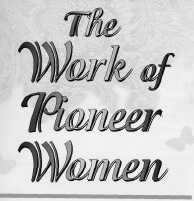
Ellen More Nordhauser Pioneer women are often featured in parades, school programs, and historic re-enactments. Usually, they are represented as clean and healthy-looking whites of various ages, clothed in immaculate gingham or cotton print dresses, with aprons and sun-bonnets. This essay seeks to modify that picture by including with the many white women, Native American and African American women, and by looking more closely at the labor these workers performed in the early agrarian and village economy of Illinois before 1840. Native American women were, as John Mack Faragher reminds us in Sugar Creek, the first pioneers. In their societies of people speaking Algonquian languages, women of Illinois tribes—Kickapoo, and Sauk and Mesquakie [Fox], among other groups— performed many important tasks, including the building of bark longhouses in the summer villages, which were usually located near rivers and which might house several hundred people. Shared by six to ten families, these permanent summer houses were often made of cut saplings, bent to form a frame and covered by the bark of American elm trees. Winter lodges were smaller and were covered by weatherproof mats made of cattails, harvested in July and sewed together. Cattail leaves were woven into mats used on sleeping platforms. All of the collection and preparation of these materials and all of the construction of homes was done by women. 23
In their societies, before the influence of Europeans became evident, women were also the farmers and processors of meat. While men supplied protein in the form of animal meats and fish, women grew maize, squashes, and beans, as well as tobacco. Men cleared land for the fields. After the fields were cultivated and planted by women, and after earth had been hilled around the sprouting corn, most villagers left for the summer buffalo hunt. (The last buffalo were seen in Illinois about 1800.) On the hunt, women removed the meat from the bones with knives of flint and bone scrapers. They dried much meat over fires and also processed the hides. After families returned from the buffalo hunt, women harvested their crops of corn, beans, and squash and dried them for storage. They also gathered wild foods, such as pecans and persimmons, which, together with dried corn and vegetables were stored by women in pits they had dug for that purpose in the summer village. At the conclusion of the harvest, women burned the dried stalks and vines to prepare the field for next spring's plantings. During the winter, families left the summer During February and early March, before heading back to the permanent summer villages, families—both men and women— stopped at groves of sugar maple trees and tapped them for sap to make maple sugar. These groves had been carefully tended by the families, who, during the year 24 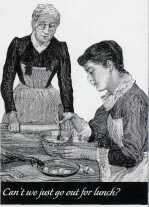
fires built by men and dropped the hot stones into the sap to boil it, which left the sugar to be scraped away by women and wrapped in containers of bark. Returning to the village with their sugar, families opened the storage pits and retrieved the dried vegetables and meat preserved by women the previous autumn. John Mack Faragher notes that "women used maple molasses as a sweetener in vegetables, fish and meat, sometimes mixing the sugar with bear's grease for storage and using it later as a basting over roast venison or duck." Families also drank the sap, which was harvested at the end of winter, thus providing important nourishment when other food supplies might be scarce. In thinking about and imagining the lives of people in early Illinois, we need to realize that other families lived here, loved each other, and used the rich natural treasures of this land before the arrival of Europeans. Historians lack written documents from Native American people living in Illinois during the seventeenth and eighteenth centuries. Our information comes from accounts handed down in oral traditions and stories of tribal groups, from tribal songs and poems, and from descriptions penned by later white observers. Native American women influenced the later pioneers in many ways. Native women's method of planting corn, by making the field into rough squares with hills around the sprouted maize, and the Some white women who came to Illinois as pioneers before the Civil War left written accounts, formal memoirs, or letters that are useful to historians. Men who wrote guides for travelers and prospective pioneers or stories of their trips through Illinois also included descriptions of different kinds of women whom they saw living in antebellum Illinois. From these sources, historians can reconstruct some aspects of the working lives of these women, most of whom were engaged in labor on farms with their husbands or as family servants, with still others working as "help" in rural taverns and stopping places for travelers. All accounts agree that women's work was hard and that moments of leisure were rare. Women wore sunbonnets, but not because they were pretty. In the days of log cabins with dirt floors or, in rarer cases, "puncheon" floors made of logs sawed in half and laid together with the flat part forming a floor—before railroads brought boards for balloon-frame houses from Chicago into the countryside—women worked outside for much of every day and they wore sunbonnets to protect their faces and necks from sunburn. Often without windows and lacking insulation, log houses were dark, frigid in winter, and hot and mosquito-infested in summer. Because they cooked on sooty fires, tended vegetable gardens, fed, milked and butchered animals, and often also worked in the fields with their husbands, pioneer women were not making a fashion statement by wearing aprons. Aprons offered some protection to their dresses. The aprons, bonnets and dresses—even those of wealthier women with servants—were often stained or streaked with dirt, grease, and grime. Washing clothes proved to be one of the most grueling of pioneer women's tasks. In a country without grocery stores, women made their own soap, outside, using wood ashes and melted pork fat (lard) or beef fat. Rebecca Burlend, an English woman who immigrated in 1831 to Pike County at the age of thirty-eight with her husband and five children offered the following recipe for soap: 25 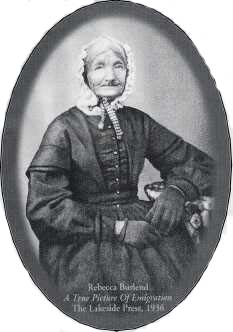
. . . we had before this time killed two pigs, the entrails of which we had cleaned and preserved, along with the bits of offal, rendering, scraps &c., and now the finest of our ashes were collected and put into a large wooden trough, and boiling water poured over them, whence we obtained a strong solution of potash, which we poured off and boiled down. . . to about one third of the original quantity, by which means the solution became so caustic, that it would have taken the skin off one's fingers in a moment. In this state the waste meat and entrails were mixed with it, which it very soon assimilated. After it had obtained the consistency of soft soap, it was poured into a vessel. . . to be ready for use. Rebecca Burlend's account is loaded with descriptions of woman's work, including work in the fields. She, husband John, and their oldest child (a boy of seven), had, in March 1832— their first spring on the land—cleared, hoed, and planted nearly four acres of corn. Earlier, they had planted three acres of wheat. At the end of June, when the wheat was ready for harvest, her husband, John, fell on a sickle, which deeply cut his knee and made him unable to walk, much less work in the field. There was a "window" of ten days between the wheat being ripe and the seeds dropping off the stalks to the ground. Harvest had to be completed within this time. Rebecca and her seven-year old son cut the crop with sickles. "I took my eldest child into the field to assist me," she wrote, "an[d] left the next in age to attend to their father and take care of the youngest, which was still unweaned." Rebecca was due to have another baby in two months. "I worked," she said, "as hard as my strength would allow; the weather was intolerably hot, so that I was almost melted." After they had cut the wheat and bound it into sheaves, it was, she noted, "still unhoused. . . ." At this time, the Burlends had no animals that could be harnessed to a wagon to hold the wheat. So she took two poles, laid them two feet apart, and placed a load of sheaves on them. "I then," she remembered, "caused my little son to take hold of the lighter end, and in this manner we gathered together the whole of the three acres." By this time, her husband was able to hobble out to the shed to show her "how to place the sheaves in forming the stack." Although, in theory, women Unlike Rebecca Burlend, who came from a background of economic struggle, Eliza Julia Flower, who had come in 1817 from England to Edwards County in eastern Illinois near the Wabash River and the town of Albion, was a person of relative privilege on the Illinois frontier. Married to George Flower, who had inherited large wealth, she mothered a large family, occasionally employed servants, and in 1833, when she wrote this letter to her nephew, lived in a spacious and comfortably furnished home that had been created by joining seven log cabins. But, even in this richer setting, women's work was, by modern standards, extensive. "We," she wrote,"(both Men and Women)—are obliged to put our hands to whatever work is required to be done no matter how important or how menial, for instance. . . I Cook, Clean, Wash, Receive Company, Nurse my Children, Visit,—do all that comes to hand as a matter of course. . . ." She continued, 26
Our Eldest Girl Emma, 14 years old, milks the cows, feeds the pet Lambs—learns her daily lessons—makes her own clothes—rides on Horse back, bridles and Saddles her own horse—Collects the Eggs—raises the Poultry, dances well,—makes Pies Puddings Bread etc—Alfred our Eldest Boy 11 years old is sole shepard [sic.] of our flock of sheep-consisting of 4 or 5 hundred, feeds them night and morning takes them out in the Prairie to graze-brings them home to fold in the Evening, gets his lessons between times Chops Wood, Gardens, feeds the Pigs, and after Supper amuses himself in reading, writing, drawing or what else he pleases. The Younger Children assist the Elder ones or their Father or me. In 1817, when Eliza Flower and her husband George had first arrived in Illinois, they had lived at first in a leaky log cabin with no real hearth, just a hole in the "puncheon" floor of logs where a fire could be built. To get water for this rough first house had required Eliza to walk a half mile. Soon after their arrival, George's legs erupted with boils, and he could not walk. Two of his sons from an earlier marriage and a woman friend who had accompanied the family all became ill with "the ague," which was probably malaria, a disease common to almost all newcomers to Illinois at this time. Eliza, who was nursing their baby daughter, then a few weeks old, fetched the water, chopped wood, washed, cooked mush from ground corn, cleaned up the pus, vomit, and diarrhea, and nursed her four sick companions, who lay helpless on the floor of the cabin. As her husband wrote later, "We were carried through this period of trial by the unremitting labor and self-sacrifice of my wife . ... The incessant labor of the mother told on the infant at the breast. It sickened and died." Like many other pioneer women, however, Eliza Flowers bore many children. Her thirteen other children, born between 1819 and 1835, included another daughter in 1819, named Emma after the first child who had died, and two sets of twins. Among her 14 children, six died in childhood and eight lived to become adults. Yet, Eliza Flowers seems to have enjoyed her life in Illinois. She never expressed regret at her choice to leave England. In 1833, she described herself, in another letter to her nephew as "42 or 43 years old" and "an old woman, the mother of 12 children, grey headed and almost toothless. I am of a happy temperment [sic.] and always have been and am now very healthy—my delight is in my home." She added that her "dress" was "always black with a white turban!" So much for sunbonnets. Rebecca Burlend and Eliza Flowers, as well as other white women who wrote letters or memoirs of their lives in Illinois before 1850, were part of families thoroughly involved in the market economy of buying and selling surplus crops and land. Yet, there was another large group of women who belonged to poorer families of illiterate squatters who did not own their land and who lived mostly at the edge of the market economy, growing food and hunting for themselves. Information about them comes from the many accounts written by literate 27 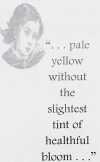
observers, who often did not sympathize with these families. The "white folks," as Christina Holmes Tillison, a New Englander labeled them, were often from the South. They usually lived in the woods on poorer land, and were regarded by more privileged and prejudiced immigrants as lazy, thriftless, and stupid. Today, we see them as representative of the less visible poverty that has often been part of rural America. Morris Birkbeck, a wealthy English Quaker who came to Illinois Territory near Shawneetown in 1816, to look for land, observed that these "neighbors of the timbered country" were not "cordial to a land-hunter." Strangers among them appeared, he wrote, "as invaders of their privileges." Although he wrote that these backwoods people were "friendly and willing to share their simple fare," he added that they were "poorly off: their bread corn" had to be ground "thirty miles off, requiring three days to carry to the mill, and bring back the small horse load of three bushels. Articles of family manufacture," he wrote, were "very scanty," and what they purchased was "of the meanest quality . . . ." Describing a family with whom he stayed while traveling in the forests of Southern Illinois, he said, "we laid our bearskins on the filthy earth, (floors there were none) which they assured us was 'too damp for fleas."' The "man, his pregnant wife, his eldest son, a tall, half-naked youth... and three daughters" were, according to Birkbeck," pale yellow without the slightest tint of healthful bloom," which Birkbeck attributed to the darkness of the forest where they lived and grew vegetables and to their unhealthy, smoky cabin, "formed of round logs with apertures of three or four inches between. No chimney, but large intervals between the 'clap-boards' for the escape of the smoke." The family's furniture consisted only of "two bedsteads of unhewen logs, and cleft boards laid across two chairs, one of them without a bottom, and a low stool." Across "the hovel," Birkbeck saw "a string of buffalo hide" used as "a wardrobe for their rags" and the family's kitchen equipment, "which consisted of a large iron pot [and] some baskets." People ate without silverware, using pieces of cornbread and their hands. John Woods, another Englishman who published an account of life in the back woods of Southern Illinois in 1822, wrote, "Woman,—they always call their wives their woman, as in 'my woman is powerfully sick and weak, and I am fetching her some whiskey."' 
Some pioneer women in Illinois before the Civil War were African American. An example is Lucy McWhorter, the wife of Frank McWhorter, an enslaved man from Pulaski County, Kentucky, who had been allowed by his owner to put aside some of the money he earned in farming and the manufacture of saltpeter—an ingredient in gunpowder—to purchase himself and his wife, who lived on a neighboring farm. They had been married in 1799. Before Frank McWhorter purchased his wife's freedom in 1817, they had twelve children, all born into slavery, only four of whom lived to adulthood. After she was free, Lucy McWhorter bore four more children, three of whom survived childhood and who, because their mother was a free woman, were also free. In 1830, the McWhorters, now both free and because of Frank McWhorter's success as a businessman, migrated to Pike County, Illinois, where Frank McWhorter had already bought 160 acres of land. They brought with them the surviving three of their free-born children and one of their slave-born sons, whose freedom had been purchased before they left Kentucky. Lucy was nearly sixty years old. The family traveled, watching constantly for outlaws who might kidnap them and return them to slavery, in a large covered wagon full of tools and pulled by a team of oxen. After posting a thousand dollar bond and a "Certificate of Good Character," both not required of whites moving to Illinois, the McWhorters started their farm. Readers can imagine that Lucy's McWhorter's work on the farm was not different from the work of other pioneer women. From Kentucky, she had brought to their log cabin beautiful hand-sewn quilts, a spinning wheel, and iron kettles for cooking. Because they owned oxen, unlike many less wealthy pioneers, the McWhorters had eighty acres under cultivation by their second year on the land. Like many pioneer women in Pike County, Lucy McWhorter sold butter and cheese. Along with money from Frank McWhorter's other activities as a businessman and town developer, the couple made enough money to purchase members of the family and rescue them from slavery before Frank McWhorter died in 1854. After his death, Lucy and her sons purchased seven more family members. Lucy McWhorter, who died in 1871, lived to be nearly one hundred years old. Another group of pioneer women appearing in the records, mostly in accounts by travelers, are those who worked in taverns or who made money in their homes by offering 28
passersby meals and a place to sleep. Since most of these accounts are written by men, they tend to picture the women according to physical appearance and in the context of services provided. Historians do not possess any documents written by women who performed these services. In 1832, William Cullen Bryant, an American writer, visited a brother in Illinois and wrote to his wife describing the hospitality he received along the way from Jacksonville to Springfield. Near Springfield, he and his brother stopped about 3 o'clock in the afternoon to get something to eat for themselves and their horses. They were met by an elderly couple, a "scarlet-faced Virginian," who gave their horses some corn, and his "tall, prim-looking wife," who served them a lunch of "bacon, a radish, bread and milk in pewter tumblers." That night, they were forced by darkness to stop at a "wretched" one-room cabin, "about half of which was taken up with beds and cribs, on one of which lay a man sick with a fever, and on another sprawled two or three children, besides several who were asleep on the floor, and all of whom were brown with dirt." A woman and an older daughter "were busy cooking supper for several travelers, who were sitting [outside] under a kind of piazza or standing about in the yard." About 10 o'clock, Bryant wrote, "the sweaty hostess gave us our supper, consisting of warm cakes, bacon, coffee and lettuce, with bacon grease poured over it." The travelers went to bed about 11 o'clock, in the crowded room, resting their heads on their saddlebags, after turning down the chance to sleep on a dirty featherbed. "The heat of the fire," Bryant recorded, "the stiffling atmosphere, the groans and tossings of the sick man, who got up once in 15 minutes to take medicine or go to the door, the whisperings of the children, and the offensive odors of the place, prevented us from sleeping." Bryant and his companion left at 4 o'clock the next morning. Patrick Shirreff, a Scottish farmer traveled through Illinois looking for land in 1834. In his account of the trip, published in 1835, he provides some information on the numerous women who offered services to travelers. Shirreff described stopping at a hotel in Pekin, "filled with permanent boarders who looked like craftsmen" and who addressed him as "stranger." He added that "a female, as usual," was "filling out tea." In Springfield, the next day, he stopped for an early breakfast "at a solitary house, which an overgrown young woman readily supplied, baking bread and stewing a fowl in a very short space of time, for which she charged well." On Salt 29 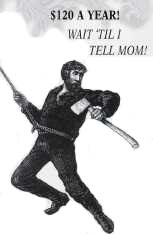
reader to compare them with the wages of men. "A good farming help [male] obtains," he recorded, "$120 a year, and an indifferent one $100 a year, with bed and board. A female help receives in private families a dollar a week. The hotel-keeper at Springfield pays his two female helps each $2 weekly in cash." In terms of wages, a pioneer woman working for someone else appears to have been better off as "help" in a public business than as a maid with a private family. Thus, the experiences and even the appearances of Illinois' pioneer women are not usually well-represented by perky costumed participants at historic sites, festivals, or historic re-enactments. The real diversity of women who were part of settling Illinois and the hard, tedious and difficult labors which they performed often remain hidden from public view. A cursory look at women pioneers also shows that patterns of work depended on ethnicity, social class and location. Rural antebellum Illinois reproduced the social prejudices and economic class systems of more settled regions. "Women" in this context cannot be lumped into a single category. Native American women, although they disappear from the narrative, must have continued to live and work in antebellum Illinois, even as their numbers were reduced by forced migration to the West, intermarriage with invaders, the fraying of tribal identities (a process which began centuries earlier) and the disappearance of Indian villages. Historians such as John Mack Faragher, Juliette Walker, and Kay Carr have wonderfully described the work and status of some rural antebellum women, but we have yet to see a history that includes much about poorer women, women who were part of families—the majority—who could not afford to buy land and who did not "persist" in communities, women who worked for wages in rural settings, or women who were indentured. A rich picture of "pioneer women" will both reflect these realities and enable us better to connect this past with our present.  Kevin J. Suess Overview Main Ideas When someone mentions pioneer women and the settlement of the frontier, one often thinks of locations west of the Mississippi River. Although this region is significant for settlement, just east of the Mississippi River one can find a wealth of pioneer settlements historically relevant to women. As the narrative indicated, the role of women has been significant from the settlement of Native Americans up to and including the settlement of whites and African Americans in the 1800s. As the students analyze and apply the ideas in the narrative, they will gain a better understanding of the role of women in the settlement of Illinois. Connection with the Curriculum The curriculum materials may be appropriate for Illinois Learning Standards regarding U.S. history: 16.A.3a, 16.A.4a, 16A5a, 16.D.3a, 16.D.2a, 16.D.2b, 16.D.3b, 16.E.2a, 16.E.3a Teaching Level The materials are designed for grades 6-10. The narrative is more age appropriate for upper grades but can be adapted for middle school students. Materials for Each Student Each student will need a copy of the narrative portion of the article and copies of the activity sheets. Textbooks, Internet access, and other resources may be necessary. 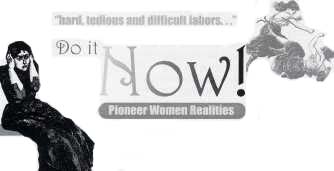
Objectives for Each Student
30

Opening the Lesson What was it like for women to live and work in Illinois prior to and during the pioneer days? The intent of this curriculum unit is to gain a better understanding of the life of women on the Illinois frontier. To begin, the teacher could have the students brainstorm words that come to mind when they think of the word "pioneer." This could then lead to a discussion of what Illinois was like before settlement. A discussion as to what role women had among Native Americans prior to European settlement can occur. Students should also reflect on the physical geography of Illinois and how this may have influenced the movement of Native Americans as well as later settlers. Additionally, students could then consider what the role of women might have been for both settlers of European and African descent. Students could describe the physical geography of Illinois. At this point students could do Activity One. Developing the Lesson After the students have read the narrative portion of the article, distribute Activity One. Students will read and listen to (if available) The Wisconsin Emigrant (from Moving West Songs by Keith and Rusty McNeil). The song was written sometime after the War of 1812, and the author is unknown. Although this song is not about Illinois, similar conclusions can be drawn from the content of the song and the role of women in Illinois at this time. After listening to the song, students need to answer the questions. Activity Two involves reading and interpreting a letter from Eliza Julia Flower, a settler in Illinois, who wrote to her nephew in England. Students are to examine the role that this woman had on the homestead. The narrative also provides more background on this letter and individual. Students should answer and discuss the accompanying questions. In Activity Three, students are to take the perspective of either a woman who has settled in Illinois or is thinking about making the move here from either out East or somewhere in Europe. Students need to use their knowledge of what life was like in Illinois during this time and compose their letter. The final activity, Activity Four, involves obituary writing. The students are to imagine that they are asked to compose an obituary for any of the women described in the narrative. Students are to analyze obituaries written for historic and famous individuals and then create their own for one of the provided individuals. Students are to synthesize the information that they have obtained thus far and compile this in a written format that best represents their individual. 
Concluding the Lesson Wrap up the lesson by discussing the different ways that women were involved in pioneer settlement in Illinois. Students could share the things that they learned, noting key differences between the experiences of the women in the narrative reading. Extending the Lesson
Assessing the Lesson One way in which students understanding could be assessed is by having students write an essay outlining the role of women in Illinois pioneer settlement. Within the essay, students would provide specific examples about women who were involved in this settlement. Additionally, students could be quizzed or tested on their understanding of the material discussed in class. 31 
Listen to The Wisconsin Emigrant Song and read the lyrics from the next page. Answer the following questions once you have read and listened to the song. 1. What is the motivation for the husband in this song to move westward? 2. Explain what you think the "hard times" are that is mentioned in the song. 3. What is the environmental perception of this region of America for the husband? 4. What is the environmental perception of this region of America for the wife? 5. How do these perceptions differ? How are they similar? 6. With what you know about Illinois and the Midwest during this time period, what is incorrect about both of these individual's perceptions? What is accurate? 7. How is the wife portrayed in the song lyrics? 32 
The Wisconsin Emigrant 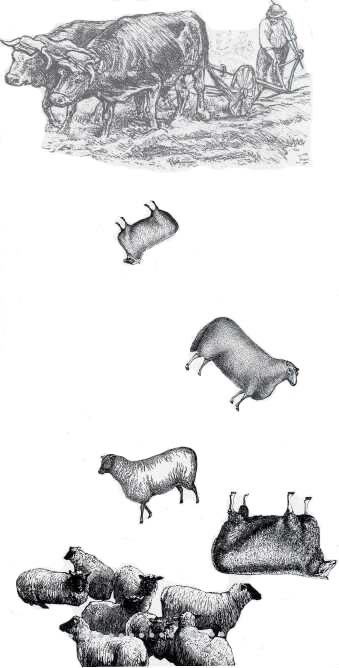
Since times are so hard, I've thought, my true heart Oh husband, I've noticed with sorrowful heart O wife, let's go; oh, don't let us wait Oh husband, remember that land must be cleared Oh wife, let's go,; oh, don't let us stay Oh husband, remember that land of delight Now wife, you've convinced me; I'll argue no more 33 
Read the letter below and answer the following questions: Eliza Julia Flower's letter to her nephew in England 1833 To Eliza's nephew: "We," she wrote, "(both Men and Women)-are obliged to put our hands to whatever work is required to be done no matter how important or how menial, for instance.. .I Cook, Clean, Wash, Receive Company, Nurse my Children, Visit, -do all that comes to hand as a matter of course.. . Our Eldest Girl Emma 14 years old, milks the cows, feeds the pet lambs-learns her daily lessons-makes her own clothes-rides on Horse back, bridles and Saddles her own horse-Collects the Eggs-raises the Poultry, dances well,-makes Pies Puddings Bread etc-Alfred our Eldest Boy 11 years old is sole shepard [sic.] of our flock of sheep consisting of 4 or 5 hundred, feeds them night and morning takes them out in the Prairie to graze-brings them home to fold in the Evening, gets his lessons between times Chops Wood, Gardens, feeds the Pigs, and after Supper amuses himself in reading, writing, drawing or what else he pleases. The Younger Children assist the Elder ones or their Father or me. Eliza Julia Flower  1. What is the intent of this letter? Why did she write this letter? 2. What conclusion can be drawn pertaining to the importance of the family structure during this time period? Explain. 3. How does one's gender impact one's duties? Describe a day for a pioneer woman. 4. From what you can understand from the letter, what was the role of children during this time in Illinois? 34 
Using the information from the letters in the narrative, you are to write a letter from either (a) the perspective of a woman has settled in Illinois and is now writing back to her family out East or (b) from the perspective of a woman who is out East or back in Europe that is considering the move to Illinois. If you choose (a) you are to describe what Illinois and frontier life is like for you. In your letter, explain what kind of work you are involved in and the challenges you face on a daily basis. If you choose (b), you can imagine that you were the recipient of a letter from any of the women mentioned in the narrative portion of the article. In your letter you are to express you curiosity of what Illinois is like and the fears you might have about moving. 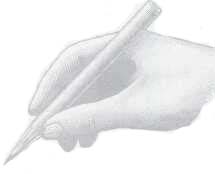
35 

Students are to create an obituary for one of the women from the narrative or any other woman they can identity from the same time period. In writing an obituary the students should emphasize important events that the individual was involved in and the impact their life had on others. The obituary should be creative and include information from the narrative. Use the following resources to help write an obituary: The Art of Obituary Writing, (includes streaming video) http://www.npr.org/templates/story/story.php?storyid=1079988 Ancestor Hunt - Obituaries of Famous People, http://www.ancestorhunt.com/headlineobituary.html Famous Obits http://www.earlyamerica.com/earlyamerica/obits/ LifeStoryNet http://www.lifestorynet.com Public Figures http://www.obits.com/ 36 |
|
|